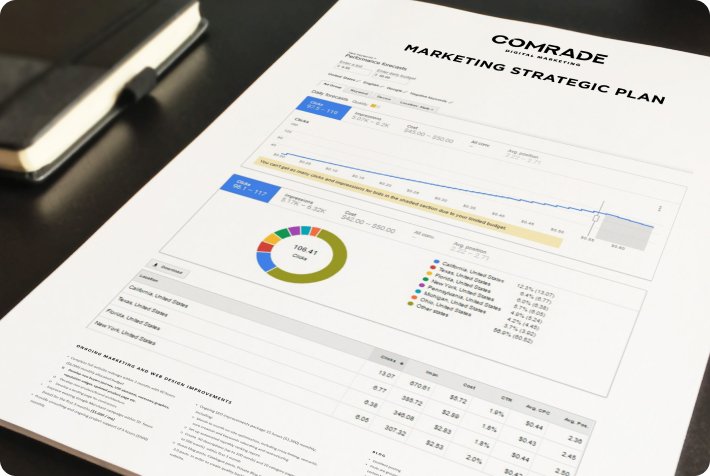Magento is an open-source eCommerce website platform owned by Adobe Commerce. It helps brands build multichannel experiences for B2B and B2C customers. More than 20% of the top 1000 eCommerce retailers in the US and Canada use Magento, making it one of the more popular eCommerce platforms. Magento allows online merchants to sync their stores with Amazon and integrate their product catalog with Google Merchant Center and Google Ads, as well as the Adobe Experience Cloud.
Yet, to fully leverage its eCommerce power, you need to implement strategic on-page search engine optimization.
Welcome to our Magento SEO guide, designed to help you get the most out of this fantastic eCommerce giant.
What Is Magento SEO?
SEO focuses on optimizing elements on your Magento website like page speed and keyword density to improve search engine visibility and organic traffic. In practice, this means when your potential customers search for things online, your eCommerce store will rank on search engine results pages (SERPs) because the keywords they use correspond to those on your eCommerce web pages.

Achieving successful search engine optimization entails publishing relevant, high-quality content, and optimizing headlines and HTML to drive qualified traffic to your online store. Ultimately, this increased traffic multiplies leads and sales.
Why Is SEO Important for Your Magento Website?
The gist is: Magento SEO drives sales, and while business growth is the overarching goal for most eCommerce businesses, there are other nuanced advantages that come with on-page optimization.
But before we get into that, let’s briefly explain how on-page SEO works and relates to search engines and eCommerce.
Is Magento Good for SEO?

There’s no denying building a website on Magento requires the help of expert developers who have experience in programming PHP systems. Yet, the question that arises most often is less focused on outsourcing developers and more on whether the platform is SEO-friendly.
Magento is a great platform for search engine optimization because it comes with Magento SEO optimization features built to make your online store rank high in organic search. The only thing you need to be aware of is while some SEO-centric features are enabled by default, they do require additional tweaking to get the best site ranking and conversion rates.
Since Magento is open source, you have a lot of control over Magento SEO. Its basic out-of-the-box features are enough to make it a competitive eCommerce platform, and with the addition of third-party plugins, there’s no virtually no limit to what you can accomplish.
Magento Features That Will Improve Your SEO
Below are the key SEO features that make Magento commerce an attractive option.
Navigation links tell search engine crawlers which pages are most important to your site. In an eCommerce context, they typically appear for product pages and categories—specifically in the menu—and serve as gateways for users to access products they prefer.
A number of eCommerce platforms generate these links automatically or make it difficult to change. Thankfully, Magento provides complete control to change these links, which improves SEO. Ideally, you want to be able to control navigation links, so your web pages have keyword-rich links that help users effortlessly navigate your Magento website.
2. Unique Canonical URLs to Prevent Content Duplication
Duplicate content is a common search engine optimization issue, often due to the same product within an eCommerce store being listed under two separate URLs. From a Magento SEO standpoint, you can easily rectify this issue by setting a canonical tag to appear on category and product pages.
Once you implement suitable canonical tags, search engine bots will know which link is the original. This doesn’t just help manage and control the canonical settings for each page, but also avoids duplicate content and better distributes link juice. As a result, your Magento store will be more SEO-friendly.
3. Fast Website Loading Speed
As page load times increase from one to three seconds, bounce rates increase by 32%. That’s why site load times have a significant bearing on SERP rankings. Firstly, Magento’s architecture is specifically designed to handle stores with heavy volumes of traffic, and secondly, the platform offers numerous SEO extensions that increase site speed.
These include using flat catalogs to reduce SQL queries to cached storage and merging JavaScript and CSS files, both of which are frequent culprits of lagging web pages. Most of these features can be accessed within Magento’s configuration settings.
4. Content Management for Organic Traffic and Link Building
Plenty of website builders come with pre-built CMS functions that limit specific extensions, especially when it comes to content creation and blogging capabilities. Because the Magento platform is open-source, it offers unlimited customization—whether your chosen content solution is built from scratch or from a third party.
With a Magento website, you have free reign when creating topical, engaging, and shareable content. Attracting high-quality links is also easier because Magento follows search engine optimization best practices allowing you to properly optimize your content, which helps users make informed buying decisions.
5. Strong Data Encryption and Security
Magento automatically encrypts confidential information like credit card information, payment and shipping module passwords, etc., with its built-in, enciphered AES-256 algorithm. Other CMS platforms like WordPress, for example, don’t natively encrypt this type of data.
When installing Magento 2, you can let the platform generate an encryption key or create your own. The Magento Encryption Key tool permits you to set a key as you need it. You should rotate your keys regularly—between one and 12 months—to maintain optimal security.
From a Magento SEO perspective, website security is important because it keeps users safe and sends signals to Google that can influence rankings. What’s more, shoppers are far more likely to do business with brands they can trust.
6. Customizable Page Titles and H1 Tags for Higher Conversions
Creating independent page titles is paramount as they appear in SERPs and help users identify products for purchase. Unlike other platforms that auto-generate page title tags, Magento allows you to create your own, which helps prevent traffic cannibalization and improves click-through rates.
Heading tags are also important because they grab your visitors’ attention once they enter your Magento website. H1 tags help focus users’ expectations and allow them to quickly discern if the page has information they’re interested in. Magento’s customization capabilities let you experiment with different keyword combinations to attract your target audience.
7. Improved XML Sitemap
An XML sitemap is essential to help search engine bots index product pages and understand your Magento store’s website structure. Magento eCommerce websites tend to have active content and pages that are not well-connected, yet an HTML sitemap ensures crawlers index your website more thoroughly.
Magento XML sitemaps can automatically be submitted to Robots.txt to provide instructions to search engines on how to crawl your website. You can also set XML sitemap file limits to specify the maximum number of URLs per file and the maximum file size when configuring the sitemap. Additionally, all images are automatically added to Magento sitemaps.
8. Easily Add Google Tag Manager
Google Tag Manager is a free tag management system that allows you to manage and deploy tracking pixels on your website or mobile app without having to modify code. These tags are an important part of analytics because they allow you to monitor and track conversions.
With Magento 1, you had to install a plugin; however, Magento comes with integrated Google Ads conversion tracking. Therefore, you can easily add Google Tag Manager in Magento without any third-party extensions.
9. Advanced Analytics and Reporting
Implementing Magento SEO strategy without analyzing data is like investing in stocks and never monitoring the market. Magento integrates with Google Analytics and Website Optimizer and provides detailed insights into customers’ needs.
A compelling feature is its ability to monitor behavioral trends and outline a plan of action with its inbuilt reporting system. Compared with other open-source software, you don’t need to configure reports and analytics to show critical marketing and sales reporting dashboards.
Without modifications, Magento’s native platform offers valuable insights to accelerate your business. Given that it connects seamlessly to most types of databases, you’re also not limited to specific data visualization tools. Extensions on Magento’s marketplace can also unlock advanced functionality, which would likely be inaccessible on simpler platforms like Shopify.
10. Increases Brand Awareness
SEO nudges customers to your store in the most organic way. While traffic derived from pay-per-click advertising costs money, SEO generates leads and customers from unpaid sources. Most notably, the traffic that comes from organic search results is always more valuable because it’s a result of your inbound marketing efforts.
11. Amplifies Content
Search engine optimization plays an integral role in content discovery. The whole point of digital marketing and content marketing in particular is to attract, engage and retain an audience by creating and sharing relevant content.
No matter how good your content is, you still need on-page SEO to get it noticed online. Besides, there is no point in creating inbound marketing content if you’re not implementing Magento SEO tactics to boost your content and your website’s visibility.
12. Creates Lasting Value
Paid advertising has its benefits; however, its value stops the moment a campaign comes to an end. So, while you might amass a large sum of traffic and brand awareness, this is short-lived.
SEO, on the other hand, is a long-term investment that works 24/7. Sure you have to invest some capital at the onset, but this will continue delivering a high ROI, even once you’ve paid the initial upfront costs.
Magento SEO innately generates great value in terms of user experience, content, and design for your eCommerce website.
How Magento SEO Works
Search engines like Google or Yahoo! and Bing enable users to locate information on the internet. Every day millions of people type in queries they want answers to, and these search engines provide them with a list of the best possible websites, i.e., information that best answers their questions.
But how exactly do search engines decide which URLs appear on search engine results pages (SERPs)?
Each search engine has what we call search engine robots that collect and gather data, which is then indexed and filtered through an algorithm to match users’ requests.
There are several factors that algorithms consider and on-page is one of them. For instance, if a user types in “beach umbrella” and your store has the keyword “beach umbrella” in its page copy then it should appear in SERPs.
Of course, this is a simplified explanation, and it’s a little more complex than that, but you get the idea. Google wants to offer the best user experience to its visitors, so it’s always going to rank the websites that meet its user’s criteria the highest.
21 Magento Tips to Grow Your Ecommerce Store
Right out of the box, Magento is already one of the most SEO-friendly eCommerce platforms, but there’s still plenty you can do to curry favor with search engines and attract more visitors than your competition.
1. Choose High-Quality Hosting

Poor-quality website hosting compromises on-page SEO, especially if it has a slow loading time. Websites that take too long to load are penalized by search engines and rank lower on SERPs.
According to Google, 2.5 seconds is the ideal loading time, and more than 4 seconds is considered poor. Therefore, as a prerequisite, your website host should provide excellent infrastructure with fast site speed.
Most eCommerce stores use dedicated hosting as shared hosting is often ineffective for large, complex websites. The established web host, Bluehost, is one of the best for Magento stores as it comes with a reliable track record, ample disk space, and unlimited data transfer.
2. Use File Robots.txt Files

Robot.txt files tell search engine robots which URLs they can and should access in your Magento eCommerce site. Websites don’t have to have these files, although they help SEO by preventing crawlers from indexing incorrect pages.
The presence of these files is not compulsory for the operation of a website, but at the same time, its correct setup lies at the core of SEO. For example, messages that clients receive after completing an order or filling out a form are generally not indexed by Google because they don’t have true SEO value.
You can read the Magento User Guide to ensure your pages are correctly configured.
3. Create an XML Sitemap

An XML sitemap is a list of website pages within a domain. It provides search engines with important information about your pages, videos, and other files on your website, as well as the relationship between them.
It’s like a directory for all your pages allowing search engine bots to quickly scan and index your website. Not having an XML sitemap, specifically created for search engines, means missing out on a second chance to be indexed by Google.
Unlike Magento 1, Magento 2 does not support auto-generated XML maps. However, third-party plugins can easily combat this minor inconvenience.
4. Enable Canonical Tags

Canonical tags are a powerful way to tell Google and other search engines which URLs you want them to index. A canonical link meta tag will prevent duplicate content issues if you have different versions of the same page and ensure your SEO is on point.
On the Magento platform, it’s possible to edit URLs to help Google assign the correct search value to different pages with similar content. To avoid duplicate pages, you either have to remove the category from the URL, so each product has its own address, or leave only one category path in a product URL key.
5. Don’t Forget About the Hreflang Tag

Some Magento eCommerce stores have multi-store views, i.e., they contain the same content in English but are targeted at different markets. Often Google can’t identify subtle changes in currency, for example, and assumes these pages are duplicate content, which is where Hreflang tags really help.
To troubleshoot this issue, Magento has a Hreflang tag (code) to distinguish between pages that have different URLs with more or less the same content, so on-site SEO isn’t negatively affected.
6. Conduct Keyword Research

Keyword research is the bedrock of on-page SEO. It tells you what terms your customers are actively seeking, and the competitiveness of those keywords, and helps shape your content plan and web copy to ensure your website and marketing assets rank high on SERPs.
Keywords research is important for three reasons:
- It tells you what people are searching for, rather than what you think they’re searching for.
- Search engines only rank our website if they know what it’s about. Using relevant keywords on different pages of your Magento website means Google can rank you for those keywords.
- Identifying relevant keywords to use in blogs and other marketing assets can drive large volumes of qualified traffic to your website.
Keyword research is the starting point of all digital marketing efforts. It’s an ongoing process, so if you’ve had the same keywords for the past six months, you might want to conduct an audit and update ones that are no longer relevant or popular.
Once you’ve completed keyword research, you can go about creating content and pages focused on those keywords. Combined with other SEO strategies, this will help search engines and people find your website online.
7. Make Sure Your Website Loads Fast
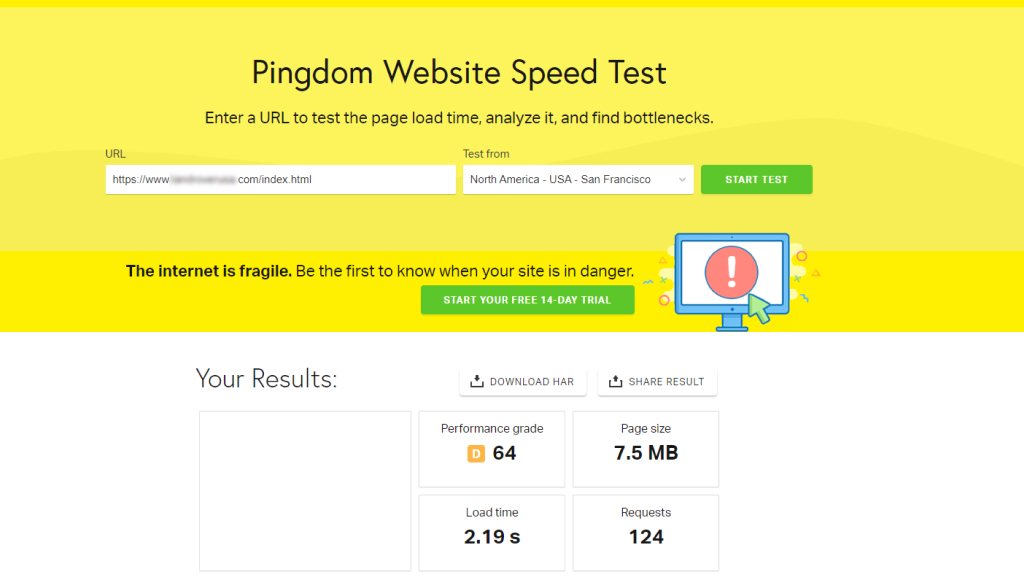
To increase visitor engagement and reduce bounce rate, it’s essential your Magento store loads fast. A website optimized for fast site speed enhances user experience (UX) and keeps visitors interested for longer, elongating the window for potential conversions.
A one-second delay can result in 11% lower page views. A slow website can be caused by unoptimized images, bandwidth throttling, large JavaScript files, server response time and too many advertisements.
Most of these issues can be resolved with a little professional SEO help. Beyond image compression and minifying Javascript files, you might consider using a content delivery network (CDN).
If your website is hosted on one server, each user who visits will send requests to the same server. This means that when your website experiences high levels of traffic, the time it takes to process each request slows down the load times for all of them.
However, with a CDN, you cache your website on a global network of servers, so when a user’s browser requests files from your site, that request is routed to the closest server speeding up loading time.
8. Is Your Magento Store Mobile-Friendly?

As far back as 2015, mobile searchers outnumbered desktop searches. Shortly after, Google switched to mobile-first indexing and started indexing and ranking the mobile versions of websites.
Mobile user experience plays a major role in search engine rankings—even in desktop search results. User experience has always been a factor in rankings, and mobile experience is paramount.
Screen size, simple navigation, and finger-friendly navigation are design considerations eCommerce stores have to consider when creating their online platforms. Consumers also interact with brands across platforms and devices.
It’s not uncommon to put products on their wishlist using their mobile and then check out those products using their laptop and vice versa. A great website design combines beauty and functionality, underpinned by strong SEO. Your Magento website is no different!
9. Publish High-Quality Content

Marketers speak about the importance of quality content, but what does that mean?
A blog can be well written and objectively be “high-quality” but if it doesn’t have any keywords, its SEO performance will be dismal. In the world of digital marketing, this does not equate to high-quality content.
Similarly, content filled with keywords in an effort to rank high in SERPs is also poor quality.
If we had to compile a Magento SEO guide for quality content, we might put forth the following considerations:
- Contextually relevant and personalized. These criteria are the baseline table stakes. Your Magento marketing content must be tailored to address a specific context. Always ensure the content you’re creating is in the right format and distributed on the appropriate platforms.
- Findable. Your content must meet minimum Magento SEO requirements such as having the correct keyword, meta descriptions, meta tags, and image tags, etc.
- Useful and Insightful. One of the core tenants and SEO features of inbound marketing is creating valuable and useful content for audiences. So, your content should be helpful to your customers.
Apart from content marketing assets, it’s important to optimize all your website content. Every page’s meta description and meta title should be optimized, as well as your website’s “about” pages and so on.
Start a Blog
While on the subject of content, starting a blog should be part of your search engine optimization strategy. Your Magento store might be unable to rank for keywords only using product pages or category pages.
While Magento doesn’t support blogging, the Magento Blog extension from Magefan can help, or you can also link a WordPress blog to your store. We highly recommend setting up a blog to keep your website content fresh and to ensure search engine crawlers regularly index your content.
10. Ensure You Have the Latest Version of Magento
Software updates are often overlooked, but when it comes to Magento SEO tips, the first thing you should do is check you have the latest version. In addition to security fixes, software updates usually include new or enhanced features or improved compatibility with different devices and applications.
You can either manually update through the System Upgrade in the backend or ask a professional developer to help you. The updating process can be time-consuming and complicated. Most times it’s best to hire a professional’s help—unless you want to handle search engine submission settings, merge CSS files, etc.
Magento’s latest update introduces improvements to platform quality, payment methods, GraphQL caching performance, and accessibility. Updating your platform can improve stability, remove outdated features and ultimately make for a better user experience.
11. Install the Defer JavaScript Extension
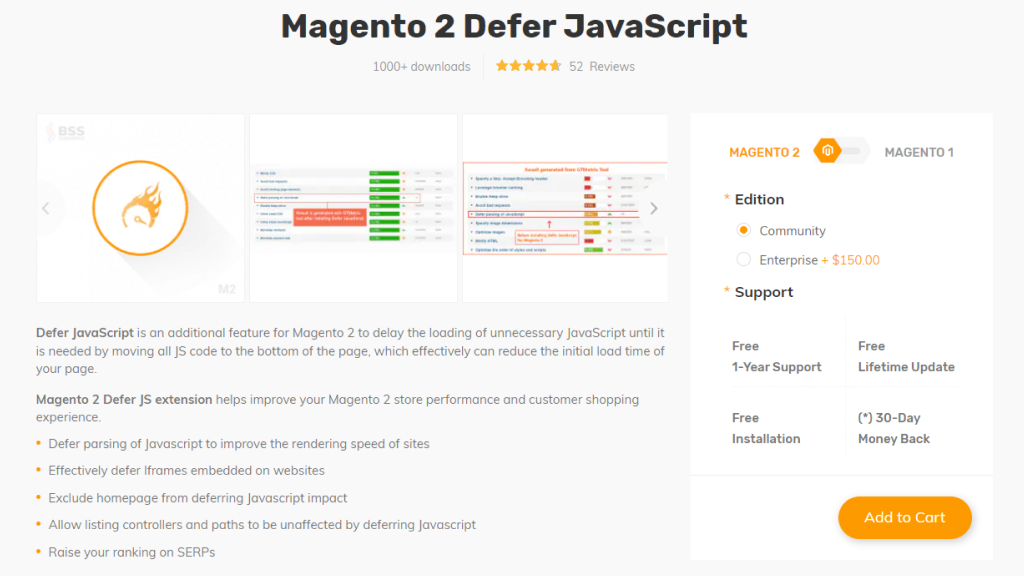
Using Defer JavaScript delays JavaScript loading until the last minute when all HTML and CSS loading is finished to speed up your website. With this extension, merchants don’t have to worry about losing customers due to slow site speeds.
Optimizing your website’s page speed by deferring Magento Javascript gives your eCommerce store a better chance to rank higher than other competitors with poorer performance.
12. Use Support Google AMP

Support Google Accelerated Mobile Pages (AMP) is an open-sourced project designed to make all mobile pages extremely fast. This plugin improves search engine visibility and increases traffic and conversion rates.
As a standalone solution, Support Google AMP allows you to make your website AMP-friendly without any additional integration with third-party services. Magento stores that use this plugin experience page load times of less than half a second.

Ajax is an extension that provides an optimized sitemap to help customers select their favorite products as quickly as possible. With Ajax, matching results reflect on your store’s pages directly after customers filter specific product attributes without reloading an entirely new page. This greatly improves customer experience and often leads to increased purchases.
14. HTTP or HTTPs?
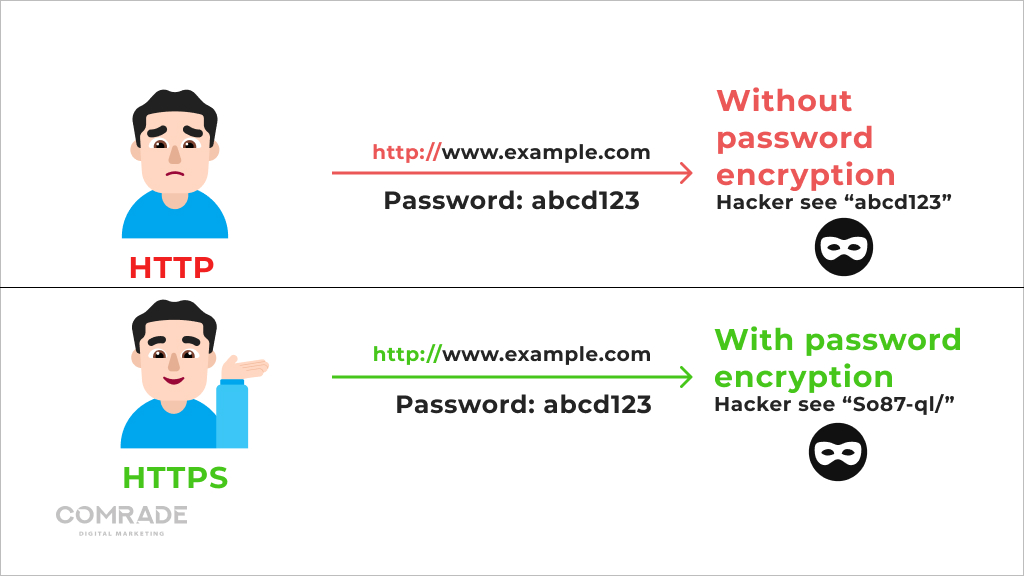
Using an HTTPS (SSL) certificate for Magento is the best way to secure the confidentiality and safekeeping of customer data. Part of Magento SEO best practices entail making sure your customers’ data isn’t susceptible to dubious third parties.
An HTTPS (SSL) certificate ensures you’re following standard authentication and security protocols. Without it, any data you enter into your site, such as passwords and bank details, can be hacked. As an eCommerce store, one of the easiest and most necessary ways to build trust is to protect confidential data.
15. Optimize Meta Tags (Titles and Descriptions)

A web page’s meta title and meta description are what customers see displayed in search results. Ideally, each should be unique to the page and contain meta keywords that match user search intent.
Meta Titles
Page titles are a strong SEO feature, so you’ll want to include your primary keyword along with keeping things descriptive to grab the attention of potential customers. A good meta title employs enticing adjectives and emphasizes customer pain points your content resolves.
It’s a good idea to type in a search query and analyze the top 10 Google search results. See if there’s a pattern, how they use keywords, and whether they emphasize certain product attributes.
Google only displays the first 50-60 characters of most page titles, so keep them under this number to avoid truncation. Furthermore, always include your main keywords near the beginning of the title, in case a web server rewrites or shortens your titles.
Meta Descriptions
Then there’s the meta description. Its main purpose is to encourage click-throughs. Think of it like your page’s elevator pitch. While Google doesn’t consider it a direct ranking signal, you should still include your target keywords in your meta description because those words will be bolded in search results.
Writing meta descriptions for every product page from scratch can be time-consuming. To minimize the hassle, you can use extensions like SEO Meta Templates which creates editable templates. Just remember, each meta description must be unique and compelling as possible, so you can maximize your click-through rates.
16. Optimize Product Images
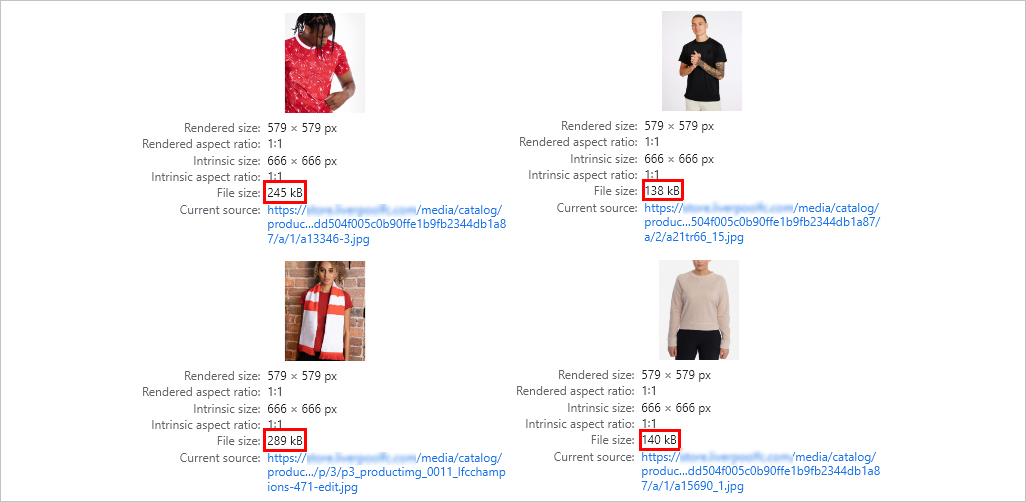
Image size impacts website speed and search engine optimization. For example, if you have a catalog page with 30 products and each product image is 1MB, that means 30 MB has to be downloaded every time the page loads. This can be a major problem for mobile devices or customers with limited bandwidth.
When you optimize your images, you want them to have a good ratio between quality and size. And you want to make sure they’re not resized by CSS but rather to your specific needs. Another technique is to use lazy loading, which loads your images after the page is fully loaded, or while users scroll through the page.
Image Alt Tags

Search engine crawlers still struggle to identify certain images, so it’s important to add image alt tags, so they can better understand and rank them.
Image alt tags should describe what’s in your images. You can include keywords here and there but don’t indulge in keyword stuffing.
The best alt-tag descriptions are detailed, specific, and succinct. For example, “girl-wearing-red-dress-on-park-swing” and not “girl-swing.”
17. Write Your Product Descriptions

Optimized product pages boost on-page search engine optimization because they provide opportunities to include keywords. People tend to view product pages the old-fashioned way—as a boring list of specifications—but today’s product pages are more like mini sales pitches, combining persuasive copy and technical information.
You should do your best to make your product descriptions informative, interesting, and detailed.
Try including the following information:
- A compelling description;
- A list of key specifications;
- Features and benefits; and
- Any warranties (if applicable)
Avoid using manufacturer descriptions verbatim. If other stores are selling the same product search engines might think it’s duplicate content.
18. Create an SEO-Friendly URL Structure in Magento
According to Google, “A site’s URL structure should be as simple as possible. Consider organizing your content so that URLs are constructed logically and in a manner that is most intelligible to humans.”
For starters, a good product URL looks like this:
- www.yourstore/women/trainers-Nike
Not like this:
- www.yourstore/women/products6859$5
Your product and category URLs should be succinct, consistent, and lowercase.
Moreover, Magento might generate a URL that looks like this:
This will immediately create duplication issues as multiple variations of the same products are on separate URLs. Therefore, it’s a good idea to use top-level product URLs without including the category URL and subcategory URL.
For example, let’s say you have a white dress in women’s clothing that fits into two categories:
The top-level product URL is:
Of course, not all SEO-friendly URLs are top-level. We merely used this as an example to emphasize the importance of clean URLs and why you should always check them.
Ideally, your URLs should be structured as follows:
- Product page: website.com/category-sub-category/product-name/
- Category page: website.com/category/
- Sub-category page: website.com/category/sub-category/
Lastly, don’t forget to include keywords in all your pages’ product and category URLs, while keeping URLs short and sweet by avoiding filler words (such as “the” and “for”).
19. Implement Schema Markup
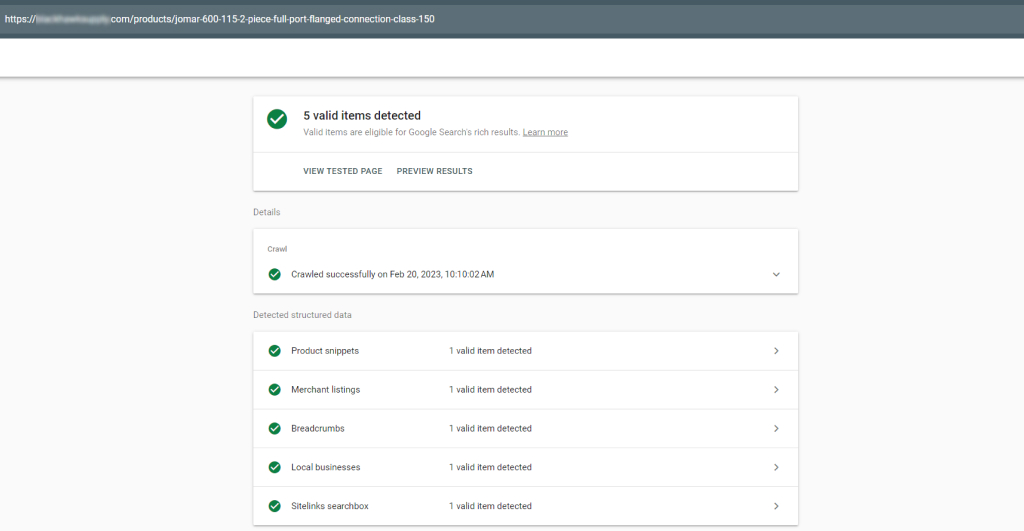
Schema markup is a type of microdata that makes it easier for search engines to organize information. Implementing it on your Magento website increases the chances of Google displaying rich snippets, i.e., additional information such as pricing reviews, and images.
Even though rich snippets don’t directly impact SEO, they appear above the #1 ranking spot on Google SERPs. So, even if your webpage isn’t optimized to rank on the first page of search results, obtaining a rich snippet can still get you there. And that is what makes these snippets so covetable.
They increase brand visibility and improve click-through rates (CTRs). Most internet users don’t bother with the second page of search results; therefore, there’s a high chance you’ll experience high volumes of traffic with rich snippets.
20. Integrate Google Search Console and Google Analytics
Data analytics helps eCommerce businesses optimize their digital marketing performance. Many Magento store owners are unaware of the advantages of in-depth insights provided by both Google Search Console and Google Analytics.
Both offer goal-related tracking and visualizations that add a new dimension to eCommerce tracking.
Google Search Console
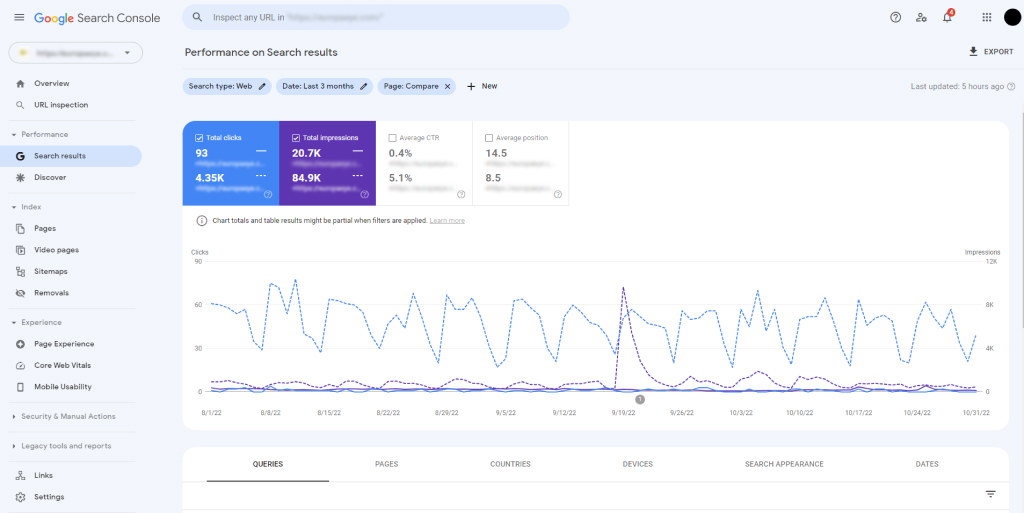
Google Search Console (GSC) is the most efficient way to measure your website’s traffic and performance. It’s part of Google’s ecosystem and integrates seamlessly with Google Analytics, offering a comprehensive toolkit to constantly monitor and improve on-page SEO performance.
It’s also possible to optimize website pages and meta tags using Google Search Console. The major difference between GSC and Google Analytics (GA) is that GSC measures search engine performance, whereas GA measures user engagement.
Google Analytics

On the other hand, Google Analytics is one of the best tools for gathering data about visitors to your website and how they interact with it. It tracks organic and paid traffic from all locations, giving you a good idea of where your visitors are coming from.
Google Analytics helps to measure sales and conversions and track campaign responses. Marketers use it to break down relevant traffic information and optimize online traffic, SEO, and content marketing efforts.
21. Run Regular Site Audits
It’s all good and well integrating the best extensions and analytics tools, but they won’t mean much if you don’t use them. And that’s the thing: These tools automate many processes, but they still need human input and insight to transform feedback into meaningful improvements.
Therefore, to keep your website running optimally, you should make it a habit to conduct regular audits. There are many website tools available to notify you if your loading speed is slow or if you have crawl issues, etc. Some even suggest what to fix—like detecting uncompressed JavaScript files or redirect chains, for example.
Additionally, they’ll alert you to technical issues that could harm your Magento SEO efforts such as broken links, SSL errors, poor mobile optimization, and duplicate content. With all the resources at your disposal, there really is no reason not to have a powerful online store that attracts customers and generates good sales.
Of course, there is always the challenge of limited time and expertise.
How Do I Set Up Multiple Stores in Magento?
One of the versatile features that make Magento stand out among competing platforms, apart from Magento search engine optimization capabilities, is its ability to manage multiple stores through a single platform from a single admin panel.
This is ideal for store owners who own or manage multiple installations and want them all on a single platform. You can have multiple stores under the same domain, set them as subdomains, or opt for entirely new domains.
Magento’s multi-stores share one of several parts of the cart system, making it possible to sell in different places at different times, which is perfect for any business operating in international markets.
Follow these steps to set up multiple stores in Magento:
- Choose your store domain. As mentioned before, you can run multiple stores on the same domain or let them each have different domains.
- Add your new store by going to the Admin Panel > “All Stores”. Then, under “Store Settings,” click “Create Store” to create the main website. Name your new store, select its root category and click “Save.”
- Next, add a default view to your stores. You can do that by selecting “Create Store View” and clicking on the new store you’ve created. Now, decide on a name for the new store view. You can then enable or disable the view. Click on “Save Store View.”
- Finally, you will have to set up the URL of your new store. Go to “Configuration” under “Store Settings.” Choose Web from the left navigation panel and click on “General” from the drop-down menu. Go to “Base URLs” and uncheck the “Use Website” checkbox. Insert the new store address next to the Base URL bar.
Creating multiple stores in Magento is relatively straightforward. Its Multistore view enables the displaying of stores in multiple languages, increases the emphasis on adjusting design aspects to bring uniqueness to each store, and eliminates the need for separate shipping configurations.
What Is the Difference Between a Website, a Store, and Store View?
When Magento Open Source is installed, a hierarchy, including the main website, store, and store view, is created.
- A website—You can design various websites like pants.com or pants.org. Each has different payment and shipping methods for products.
- A Store—It’s possible to have several stores on one Magento website. Each store can have a unique product and category structure. However, all stores will have the same currency and prices, payment and shipping methods, taxes, stock management systems, customer accounts, etc.
- A Store View—Lastly, every store can have numerous store views. These are usually used for different languages and currencies. All store views have the same categories, but you can specify different product prices.

Hire Magento Experts to Improve Your SEO
We hope you’ve found this Magento SEO guide useful. Optimizing on-page SEO for Magento is a technical process that’s rewarding when properly executed but risks going wrong if you are unfamiliar with Magento SEO best practices. That’s where Comrade can help.
We’re an eCommerce agency specializing in Magento development and search engine optimization. With over a decade of digital marketing experience, our experts can transform your eCommerce platform into a revenue-growing business. Find out more about our on-page SEO services for Magento.
Frequently Asked Questions
Where do you operate?
Comrade originates in Chicago, but we worked all around the United States. We can help your business grow and increase revenue whenever you are. We have offices across most major cities in the US. For example, we can offer digital marketing services in Denver or Miami. You can even find our internet marketing experts in Austin! If you want to know more about our Cincinnati digital marketing agency or find out how exactly we can help you, contact us via the phone or email.


